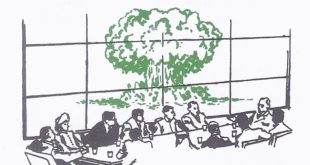The postwar stirring of nationalism among peoples in Asia and Africa, was one important outcome of World War 2, but World War 2 created another great yearning that was world-wide, the desire for a firm and lasting peace. This greatest of all conflicts had uprooted millions from their homes, destroying their means of livelihood. It had brought death, sorrow and a great war-weariness. News of the Allied victory in 1945 was received in a spirit of quiet relief and hope for the future. Following World War 2 a split developed between the free world (designated by the NATO flag) and the Communist world. The hope for peace met disappointing setbacks in the years that followed. Instead of working together, nations split into three camps — the free world, the Communist world, and the neutralist countries. As a result of Soviet policies, a “cold war” of words and threats developed. This “cold war” turned into armed conflict when United Nations forces came to the defense of the Republic of Korea. Communist-inspired crises also broke out in many other parts of the world. Problems plagued the world in recent years and the United States played a key part in the strengthening of the free world and in the search for peace. We get a glimpse of the awe-inspiring challenges of tomorrow’s world. These matters will be taken up under the following topics: How did the postwar world become divided? What steps did the free world take to meet the threat of postwar communism? What did the postwar future hold? 1945 A.D. – 1970 A.D 1. How Did the Postwar World Become Divided? Victory in World War 2 would not have been possible without close teamwork among the nations fighting the Axis powers. Then, in 1945, while the combined armed forces were crushing Germany and Japan, the United …
Read More »Nationalist Beliefs in Asia and Africa after WW 2
Nationalist beliefs in Asia and Africa swept over changes in many lands. In the spring of 1955, the city of Bandung, Indonesia, was tense with excitement. Crowds lined the streets to catch glimpses of delegates attending an international conference. The citizens of Bandung saw Arab diplomats arrive, dressed in the flowing robes and headdress of the desert. They saw prime ministers and foreign ministers wearing the jaunty caps and spotless white clothing popular in tropical South Asia. The rest of the world watched too, for the Bandung Conference was the first of its kind ever to be held. Only Asian and African statesmen were present, yet they spoke for half of the world’s people. Many of the 29 nations they represented had become independent since World War II. In short, the Bandung Conference was a symbol of the tremendous changes that swept across Asia and Africa after 1945. New nationalist feelings emerge in Asia and Africa as peoples once under colonial control strive for freedom. We read about the recent nationalistic efforts of Asian and African peoples to gain freedom from colonial control, to run their own affairs and to achieve a better standard of living. This nationalist awakening made India a free nation. It brought important nationalistic changes in Southeast Asia. It set the Moslem Middle East aflame with nationalist feeling and swept over Africa. The Communist drive to gain power round the world, but nationalist events in Asia and Africa are important to free people everywhere. 1939 A.D. – Modern Day What nationalist changes took place in China and Japan since world war 2?How has nationalist beliefs affected India and Southeast Asia?How did nationalists changed the Moslem world?How has the desire for freedom transformed nationalistic Africa? 1. What Nationalist changes have taken place in Japan and China since World …
Read More »

